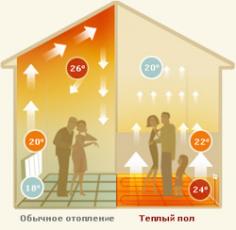Search
Login
Recommended
How to connect a warm floor to electricity. Do-it-yourself connection of a heated floor to electricity: types of floors, their installation and safety precautions.
Folk wisdom says: Keep your feet warm, head cold, and your stomach hungry. But following it is not always easy. And if you can somehow cope with the head and stomach, then what about the legs? Most heaters equip above floor level. And as a result, the floor remains cold. To solve this problem, there is a warm floor.
Table of contents
- Types of underfloor heating
- Calculation of the power of the warm floor
- Installation of a film heat-insulated floor video
Types of underfloor heating
What is a warm floor today, even a child knows. It is difficult to underestimate the comfort and coziness that he will present at home. Underfloor heating is used as an additional heating system. But it can also be used as the main heating system, replacing bulky radiators.
There are three types of warm floors:
- water;
- electric;
- film.
water heated floor
This is a system of pipes along which the coolant moves. The marking for laying the water floor is made depending on whether it will be used as the main or auxiliary system. When used as the main heating system, pipes are laid under the entire surface of the floor. When used as an auxiliary system, pipes lie only in the area where people live.
The main advantage of using a water heated floor is the low cost of its operation. The water floor cannot be installed in apartment buildings and connected to the central water supply system without obtaining approval documents, and it is very difficult to obtain them. Water floor heating is mainly used in private houses and cottages.
Two styling methods are used:
- The concreteless method does not require concrete pouring; aluminum plates laid on pipes transmit heat.
- Concreting of a pipe of a heat-insulated floor is poured with concrete up to 50 mm thick. Concrete serves as a heat distributor.
Providence of such work is best entrusted to professional builders. Indeed, in the case of poor-quality installation, you will have to disassemble the entire screed.

electric underfloor heating
In electric underfloor heating, the following is used as a heating element:
- resistive electric cable;

- self-regulating cable;

- electric mats.

A feature of the resistive cable is the ego's large resistivity, which causes large heat losses in the cable, and, as a result, its work as a warm floor. The cable is made single-core or two-core. Nichrome is used as cable cores, which has high resistance. The heat transfer of the cable will be 15-20W / m.
In a self-regulating cable, the cores are made of a material with low resistance, and a semiconductor polymer acts as a heating element, which acts as an insulation of the cores. The semiconductor properties of the material allow self-regulation in the cable.
Electric mats are assembled on the basis of a resistive cable for ease of installation. The cable is laid by a snake on a polymer mesh.
film floor heating
This floor is made from a carbon polymer deposited on a film. The main distinguishing feature of the coating is its minimum thickness of 3mm. Simple and easy installation. Suitable for any coatings: laminate, tile, carpet. The disadvantage of this gender is the increase in electromagnetic fields in the house, which, for sensitive people, can negatively affect health.

Calculation of the power of the warm floor
As mentioned above, underfloor heating can be used as additional or as the main heating. When using it as additional heating in the off-season, a bathroom, a nursery, a specific power of 100-130W / m2 will be enough. This will maintain the required temperature in the room.
When using a warm floor as the main heating, it should occupy at least 70-75% of the total heated area. For efficient heating, the specific power of one square meter should be up to 150 to 180W. When calculating, one should take into account the structural features of the premises where it will be used. So, for the first floor, the floor power should be increased by 20% and high-quality thermal insulation of the basement or basement of the house should be performed. For a glazed loggia or a winter garden, the power must be calculated based on the size of the windows, which will also lead to an increase in power consumption.
Installation of a film heat-insulated floor
Unlike the installation of a water floor, installing a film heated floor with your own hands will not be difficult. This type of underfloor heating does not require any additional construction work. The film can be laid under various finishing materials.
The temperature of the film can reach 55C. The main bend is infrared waves (90% -95%), which allows the most efficient use of this material.

Installation of the infrared floor is carried out in two ways:
- dry;
- wet mounting.
For the effective operation of the warm floor, it is recommended to use insulation material.
IMPORTANT! When installing a film of a warm floor, it is forbidden to use heat-insulating materials with an external metal coating.
Dry installation
Installation of a film heating element must be carried out: for main heating in 70-80% of the area, for additional in the region of 40%. It is advisable to place an infrared heater over the entire area of \u200b\u200bthe future floor, with the exception of furniture, large household appliances, stationary structures. Deviation from the edge of the wall by 10-40cm is allowed. To ensure uniform heating, the width between the strips should not exceed 5 cm.
IMPORTANT! Overlay of heating elements of adjacent films is not allowed; for joining, film overlay on film without heating elements is allowed.
Manufacturers of infrared floors provided for the separation of the film into sections 25cm long. The maximum length of one section should not exceed 25m. All sections are connected in parallel. To fix the film on the floor, tape is used. The film is laid down with copper conductive copper tapes. Floor tapes are connected using contact clips. Make sure that one part of the connector is on the outside of the bus and the other inside the film. Joints, contact clips, and unused copper busbars are insulated using bitumen insulation, which must be supplied with the IR floor.
The infrared floor is connected to the electric network through a temperature regulator. For floor power over 2.5 kW, it is recommended to install a separate circuit breaker.

When installing a film underfloor heating under a tile, a plasterboard sheet or magnesite plate is additionally placed on the film layer to improve the adhesion of the adhesive to the substrate, since the film has poor adhesion.





